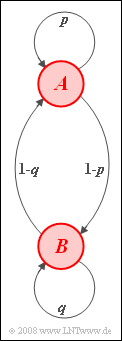Exercise 1.6Z: Ergodic Probabilities
From LNTwww
We consider a homogeneous stationary first-order Markov chain with events $A$ and $B$ and transition probabilities corresponding to the adjacent Markov diagram:
For subtasks (1) to (4) , assume:
- Event $A$ is followed by $A$ and $B$ with equal probability.
- After $B$ , event $A$ is twice as likely as $B$.
From subtask (5) on, $p$ and $q$ are free parameters, while the event probabilities ${\rm Pr}(A) = 2/3$ and ${\rm Pr}(B) = 1/3$ are fixed.
Hints:
- The exercise belongs to the chapter Markov Chains.
- You can check your results with the interactive applet Event probabilities of a 1st order Markov chain .
Questions
Solution
(1) According to the instruction, $p = 1 - p$ ⇒ $\underline{p =0.500}$ and $q = (1 - q)/2$, ⇒ $\underline{q =0.333}$ holds.
(2) For the event probability of $A$ holds:
- $${\rm Pr}(A) = \frac{{\rm Pr}(A \hspace{0.05cm} | \hspace{0.05cm}B)}{{\rm Pr}(A \hspace{0.05cm} | \hspace{0.05cm}B)+{\rm Pr}(B \hspace{0.05cm} | \hspace{0.05cm}A)} = \frac{1-q}{1-q+1-p} = \frac{2/3}{2/3 + 1/2}= \frac{4}{7} \hspace{0.15cm}\underline {\approx0.571}.$$
- This gives ${\rm Pr}(B)= 1 - {\rm Pr}(A) = 3/7 \hspace{0.15cm}\underline {\approx 0.429}$.
(3) No statement is made about the time $\nu-1$ .
- At this time $A$ or $B$ may have occurred. Therefore holds:
- $${\rm Pr}(B_{\nu} \hspace{0.05cm} | \hspace{0.05cm}A_{\nu -2}) = {\rm Pr}(A \hspace{0.05cm} | \hspace{0.05cm}A) \hspace{0.05cm} \cdot \hspace{0.05cm}{\rm Pr}(B \hspace{0.05cm} | \hspace{0.05cm}A) \hspace{0.15cm} +\hspace{0.15cm} {\rm Pr}(B \hspace{0.05cm} | \hspace{0.05cm}A) \hspace{0.05cm} \cdot \hspace{0.05cm}{\rm Pr}(B \hspace{0.05cm} | \hspace{0.05cm}B) = p \hspace{0.1cm} \cdot \hspace{0.1cm} (1-p) + q \hspace{0.1cm} \cdot \hspace{0.1cm} (1-p) = {5}/{12} \hspace{0.15cm}\underline {\approx 0.417}.$$
(4) According to Bayes' theorem:
- $${\rm Pr}(A_{\nu -2} \hspace{0.05cm} | \hspace{0.05cm}B_{\nu}) = \frac{{\rm Pr}(B_{\nu} \hspace{0.05cm} | \hspace{0.05cm}A_{\nu -2}) \cdot {\rm Pr}(A_{\nu -2} ) }{{\rm Pr}(B_{\nu}) } = \frac{5/12 \cdot 4/7 }{3/7 } = {5}/{9} \hspace{0.15cm}\underline {\approx 0.556}.$$
Reasoning:
- The probability ${\rm Pr}(B_{\nu}\hspace{0.05cm}|\hspace{0.05cm}A_{\nu-2})= 5/12$ has already been calculated in subsection (3) .
- Due to stationarity, ${\rm Pr}(A_{\nu-2})= {\rm Pr}(A) = 4/7$ and ${\rm Pr}(B_{\nu})= {\rm Pr}(B) = 3/7$ holds.
- Thus, the value of $5/9$ is obtained for the sought inference probability according to the above equation..
(5) According to subtask (2) , with ${p =1/2}$ for the probability of $A$ in general:
- $${\rm Pr}(A) = \frac{1-q}{1.5 -q}.$$
- Thus from $ {\rm Pr}(A) = 2/3$ follows $\underline{q =0}$.
(6) In the case of statistical independence, for example, it must hold:
- $${{\rm Pr}(A \hspace{0.05cm} | \hspace{0.05cm}A)} = {{\rm Pr}(A \hspace{0.05cm} | \hspace{0.05cm}B)} = {{\rm Pr}(A)}.$$
- From this follows $p = {\rm Pr}(A) \hspace{0.15cm}\underline {= 2/3}$ and accordingly $q = 1-p \hspace{0.15cm}\underline {= 1/3}$.
